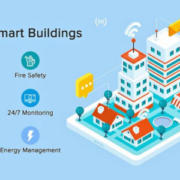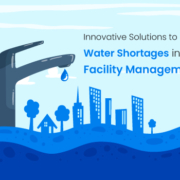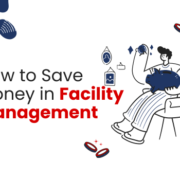How to IoT is Transforming Facility Management
/0 Comments/in Facility Management/by Arokk Integreted Management Services Pvt. Ltd.The integration of IoT in facility management marks a turning point for large buildings and corporations, leading to a new era of efficiency, safety, and sustainability. By embedding smart devices and sensors throughout their infrastructure, these entities can now monitor and control various aspects of their operations in real time.
This breakthrough not only optimises energy use and reduces costs but also enhances the working environment for employees and residents alike. In the following sections, we’ll break down the impact of IoT on facility management, showcasing its benefits and the futuristic innovations it brings to the table.
How IoT Transforms Large Buildings & Corporations?
Technology tightly interconnects with our daily lives, the integration of Internet of Things (IoT) technology profoundly helps facility management services. Large buildings and corporations benefit from IoT technologies by integrating a network of smart devices and sensors, enabling precision in monitoring and adjusting operations. This integration added advantages to facility management, making buildings smarter, safer, and more sustainable. For facility management service, IoT helps provide enhanced capabilities in maintenance, security, and energy management, providing a holistic solution to complex infrastructural needs.
As a result, these services can ensure optimal operational efficiency, safety, and sustainability, marking a new frontier in how buildings and corporations are managed.
The Smart Transformation
At the heart of IoT’s impact on facility management is its ability to turn ordinary buildings into “smart buildings.” These structures are not just constructions of brick and mortar but are integrated with intelligent systems that monitor, control, and manage various environmental and structural parameters. From lighting to heating, ventilation, and air conditioning (HVAC) systems, every component can be optimised for energy efficiency and comfort.
For instance, smart sensors can detect the number of occupants in a room and adjust the lighting and temperature accordingly, reducing energy consumption significantly. Similarly, predictive maintenance, powered by IoT, allows for the early detection of issues in building infrastructure, such as a faulty HVAC unit or a leak in the plumbing system, preventing minor problems from escalating into major crises.
Applications of IoT in Facility Management
Here are few Applications of IoT in Facility Management
Energy Management: IoT devices optimize the use of resources such as electricity, water, and gas, leading to significant cost savings and environmental sustainability. Smart thermostats and lighting systems adjust based on occupancy and natural light, reducing unnecessary energy consumption.
Predictive Maintenance: Sensors monitor the condition of equipment and infrastructure, predicting failures before they occur. This allows for timely maintenance, extending the lifespan of assets and preventing costly downtimes.
Space Optimization: IoT technologies analyze space usage patterns to maximize the efficiency of physical space. This can lead to more effective office layouts, improved worker satisfaction, and reduced real estate costs.
Enhanced Security: Integrated security systems, including smart locks, cameras, and access controls, ensure secure environments. Real-time alerts and automated responses to security breaches protect both assets and individuals.
Environmental Monitoring: Sensors continuously monitor environmental conditions such as air quality, temperature, and humidity, ensuring optimal conditions for comfort and health.
Asset Tracking and Facility Asset Management: IoT facilitates real-time tracking of physical assets within a facility, significantly reducing the time spent locating equipment and inventory. This integration enhances operational efficiency and is a cornerstone of effective facility asset management.
Compliance Monitoring: Automated systems help ensure that facilities remain in compliance with regulations and standards, reducing the risk of fines and legal issues.
Emergency Response: IoT systems can detect emergencies like fires or floods and initiate an immediate response, minimizing damage and facilitating quicker recovery efforts.
These applications of IoT in facility management not only drive efficiency and cost savings but also contribute to creating safer, more comfortable, and sustainable environments.
Enhancing Safety and Security
Safety and security are paramount in large buildings and corporate environments. IoT technologies elevate these aspects by providing real-time surveillance, access control, and emergency response mechanisms. Smart cameras and sensors can monitor for unauthorized access or detect smoke and fire, triggering alarms and notifying emergency services instantly.
Moreover, wearables and personal devices integrated into the IoT ecosystem can ensure the safety of employees in hazardous working conditions by monitoring health indicators and environmental conditions, alerting them to potential dangers.
Operational Efficiency and Cost Savings
The integration of IoT devices results in a significant uptick in operational efficiency and cost savings. By automating routine tasks and optimizing resource usage, buildings can achieve a substantial reduction in energy bills and maintenance costs. For example, IoT-enabled lighting and climate control systems can adapt in real-time to environmental changes, ensuring optimal conditions with minimal waste.
Additionally, the data collected by IoT devices offer valuable insights into building operations, enabling facility managers to make informed decisions and implement strategic improvements. This data-driven approach not only enhances the lifespan of the infrastructure but also contributes to a more sustainable and eco-friendly operation.
The Future is Now: IoT Innovations in Facility Management
The future of facility management looks promising with ongoing advancements in IoT technologies. Innovations such as digital twins, which create virtual replicas of physical buildings, allow for sophisticated simulation and analysis, helping managers to test and refine operational changes before implementing them in the real world.
Blockchain technology, combined with IoT, promises enhanced security and transparency in facility management operations, ensuring the integrity and reliability of the data collected from various devices.
Navigating Challenges
While the benefits are clear, the integration of IoT in facility management is not without its challenges. Concerns regarding data privacy and security, interoperability between different IoT systems, and the initial cost of implementation are significant hurdles. However, with robust cybersecurity measures, standardized protocols, and strategic investment, these challenges can be effectively navigated. Additionally, the complexity of managing vast data volumes and ensuring the reliability of IoT devices demands continuous attention.
Training staff to adapt to new technologies and maintaining a proactive stance towards emerging threats are crucial steps. By fostering collaboration between technology providers and facility management professionals, a pathway for smooth integration can be created.
Emphasizing scalability and flexibility in IoT solutions ensures that facility management can evolve alongside technological advancements, making these obstacles surmountable.
Conclusion: Embracing the IoT Revolution
The impact of IoT on facility management in large buildings and corporations signifies a leap towards a smarter, safer, and more sustainable future. By embracing IoT technologies, facility managers can not only streamline operations and reduce costs but also enhance the well-being of the individuals within these spaces. As we move forward, the continued evolution of IoT promises even more innovative solutions, cementing its role as a cornerstone of modern facility management.
In essence, the integration of IoT in facility management is not just a trend but a transformation that redefines our interaction with the spaces we inhabit. By leveraging the power of IoT, we can not only optimize our current facilities but also pave the way for the next generation of smart buildings.



